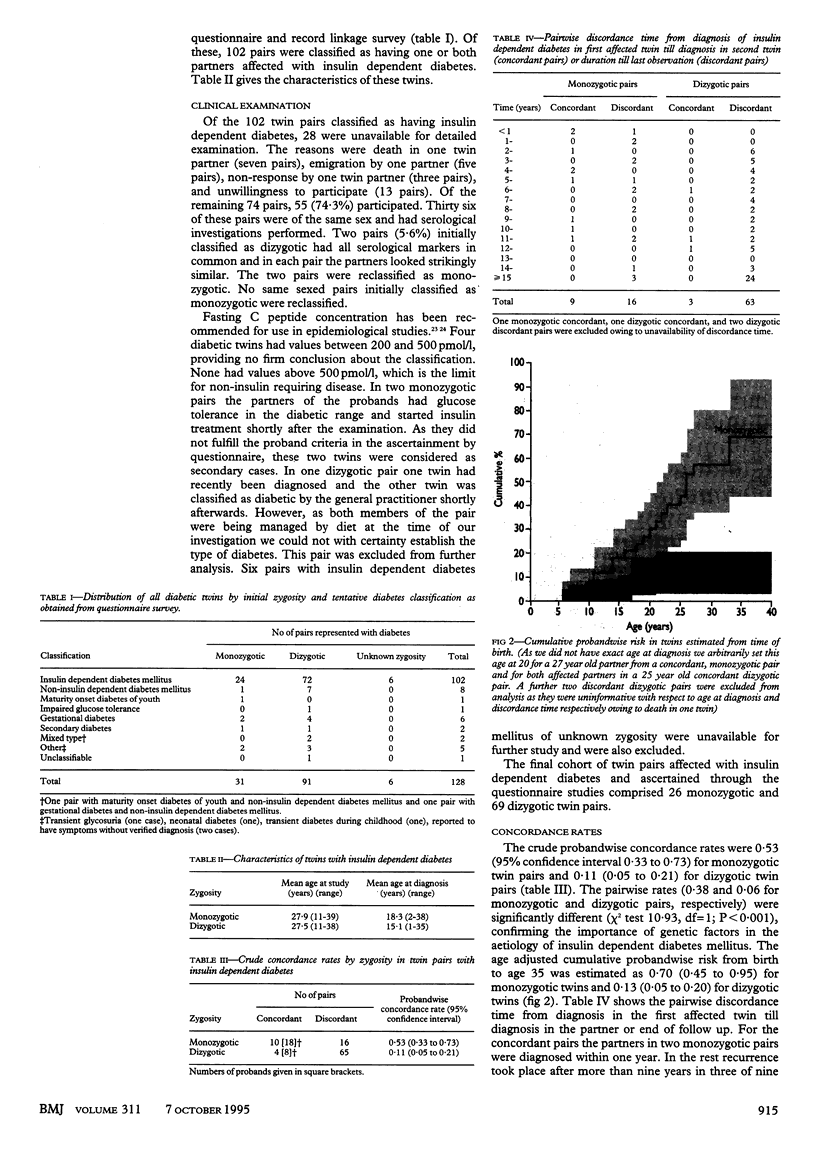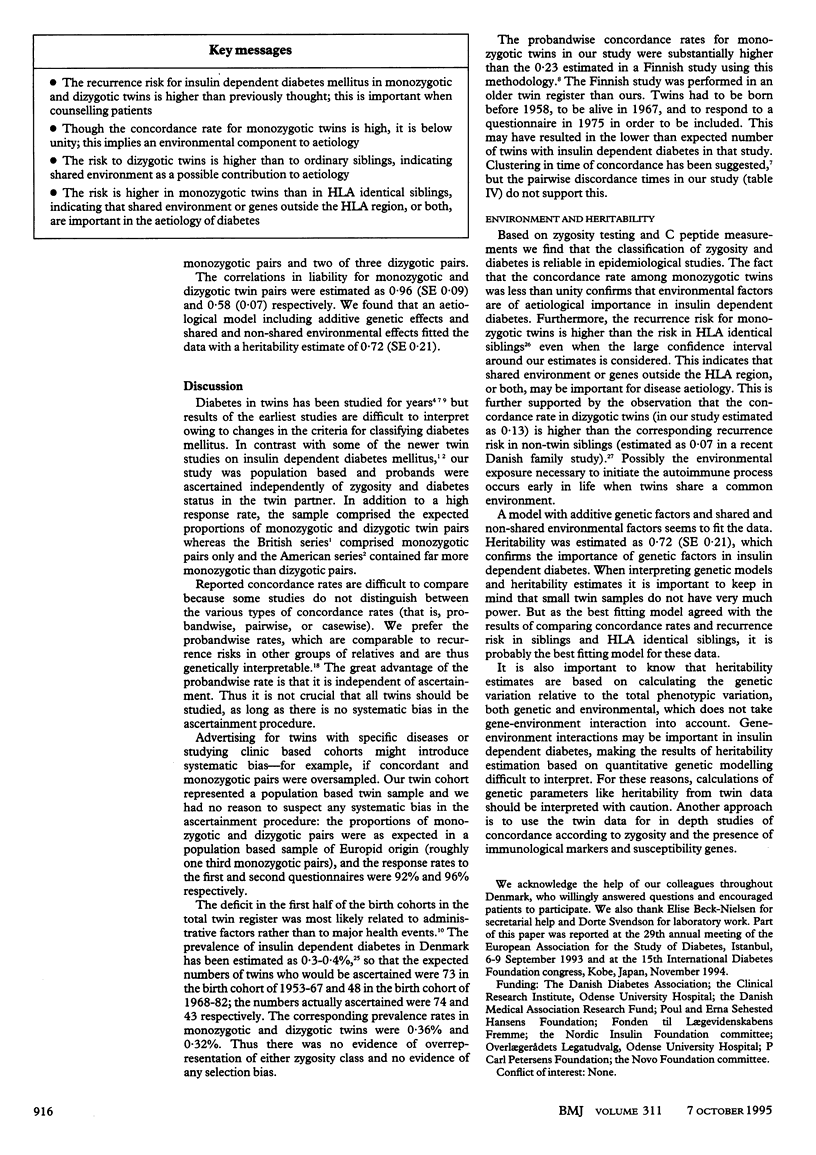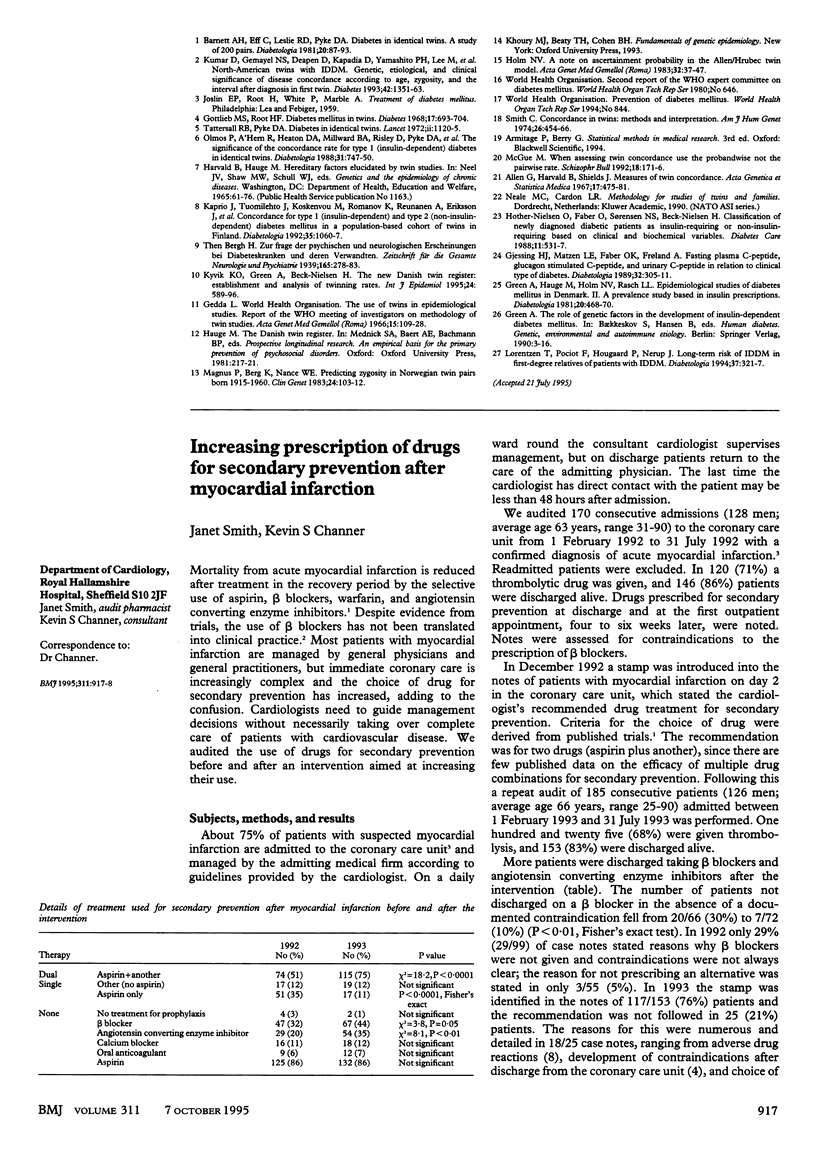Abstract
OBJECTIVE--To study the genetic contribution to the aetiology of insulin dependent diabetes mellitus. DESIGN--Historical cohort study of twins, with information on diabetes being gathered by questionnaire, verification of the diagnosis by the subject's diabetologist or general practitioner, and clinical examination in available twins. SETTING--Danish twin register and diabetic clinics and general practices throughout Denmark. SUBJECTS--20,888 twin pairs born during 1953-82, included in a population based nationwide register. MAIN OUTCOME MEASURES--Crude and cumulative concordance rates and heritability in monozygotic and dizygotic twins. RESULTS--The crude probandwise concordance rate was 0.53 (95% confidence interval 0.33 to 0.73) for monozygotic twin pairs and 0.11 (0.05 to 0.21) for dizygotic twin pairs. When adjusted for age at onset of diabetes and age at last observation among unaffected twin partners the cumulative proband-wise risk from birth to age 35 was estimated as 0.70 (0.45 to 0.95) for monozygotic twins and 0.13 (0.05 to 0.20) for dizygotic twins. The correlations of liability for monozygotic and dizygotic twin pairs were estimated as 0.96 (SE 0.09) and 0.58 (0.07), with a heritability estimate of 0.72 (0.21). CONCLUSIONS--The risk of insulin dependent diabetes in monozygotic twins is higher than previously thought and for dizygotic twins is higher than in ordinary first degree relatives. Based on the findings of this study the genetic component to the disease seems more important than hitherto believed.
Full text
PDF




Selected References
These references are in PubMed. This may not be the complete list of references from this article.
- Allen G., Harvald B., Shields J. Measures of twin concordance. Acta Genet Stat Med. 1967;17(6):475–481. doi: 10.1159/000152101. [DOI] [PubMed] [Google Scholar]
- Barnett A. H., Eff C., Leslie R. D., Pyke D. A. Diabetes in identical twins. A study of 200 pairs. Diabetologia. 1981 Feb;20(2):87–93. doi: 10.1007/BF00262007. [DOI] [PubMed] [Google Scholar]
- Gjessing H. J., Matzen L. E., Faber O. K., Frøland A. Fasting plasma C-peptide, glucagon stimulated plasma C-peptide, and urinary C-peptide in relation to clinical type of diabetes. Diabetologia. 1989 May;32(5):305–311. doi: 10.1007/BF00265547. [DOI] [PubMed] [Google Scholar]
- Gottlieb M. S., Root H. F. Diabetes mellitus in twins. Diabetes. 1968 Nov;17(11):693–704. doi: 10.2337/diab.17.11.693. [DOI] [PubMed] [Google Scholar]
- Green A., Hauge M., Holm N. V., Rasch L. L. Epidemiological studies of diabetes mellitus in Denmark. II. A prevalence study based on insulin prescriptions. Diabetologia. 1981 Apr;20(4):468–470. doi: 10.1007/BF00253409. [DOI] [PubMed] [Google Scholar]
- Holm N. V. A note on ascertainment probability in the Allen/Hrubec twin model. Acta Genet Med Gemellol (Roma) 1983;32(1):37–47. doi: 10.1017/s000156600000814x. [DOI] [PubMed] [Google Scholar]
- Hother-Nielsen O., Faber O., Sørensen N. S., Beck-Nielsen H. Classification of newly diagnosed diabetic patients as insulin-requiring or non-insulin-requiring based on clinical and biochemical variables. Diabetes Care. 1988 Jul-Aug;11(7):531–537. doi: 10.2337/diacare.11.7.531. [DOI] [PubMed] [Google Scholar]
- Kaprio J., Tuomilehto J., Koskenvuo M., Romanov K., Reunanen A., Eriksson J., Stengård J., Kesäniemi Y. A. Concordance for type 1 (insulin-dependent) and type 2 (non-insulin-dependent) diabetes mellitus in a population-based cohort of twins in Finland. Diabetologia. 1992 Nov;35(11):1060–1067. doi: 10.1007/BF02221682. [DOI] [PubMed] [Google Scholar]
- Kumar D., Gemayel N. S., Deapen D., Kapadia D., Yamashita P. H., Lee M., Dwyer J. H., Roy-Burman P., Bray G. A., Mack T. M. North-American twins with IDDM. Genetic, etiological, and clinical significance of disease concordance according to age, zygosity, and the interval after diagnosis in first twin. Diabetes. 1993 Sep;42(9):1351–1363. doi: 10.2337/diab.42.9.1351. [DOI] [PubMed] [Google Scholar]
- Kyvik K. O., Green A., Beck-Nielsen H. The new Danish Twin Register: establishment and analysis of twinning rates. Int J Epidemiol. 1995 Jun;24(3):589–596. doi: 10.1093/ije/24.3.589. [DOI] [PubMed] [Google Scholar]
- Lorenzen T., Pociot F., Hougaard P., Nerup J. Long-term risk of IDDM in first-degree relatives of patients with IDDM. Diabetologia. 1994 Mar;37(3):321–327. doi: 10.1007/BF00398061. [DOI] [PubMed] [Google Scholar]
- Magnus P., Berg K., Nance W. E. Predicting zygosity in Norwegian twin pairs born 1915-1960. Clin Genet. 1983 Aug;24(2):103–112. doi: 10.1111/j.1399-0004.1983.tb02220.x. [DOI] [PubMed] [Google Scholar]
- McGue M. When assessing twin concordance, use the probandwise not the pairwise rate. Schizophr Bull. 1992;18(2):171–176. doi: 10.1093/schbul/18.2.171. [DOI] [PubMed] [Google Scholar]
- Olmos P., A'Hern R., Heaton D. A., Millward B. A., Risley D., Pyke D. A., Leslie R. D. The significance of the concordance rate for type 1 (insulin-dependent) diabetes in identical twins. Diabetologia. 1988 Oct;31(10):747–750. doi: 10.1007/BF00274777. [DOI] [PubMed] [Google Scholar]
- Smith C. Concordance in twins: methods and interpretation. Am J Hum Genet. 1974 Jul;26(4):454–466. [PMC free article] [PubMed] [Google Scholar]
- ter Meulen V., Koprowski H., Iwasaki Y., Käckell Y. M., Müller D. Fusion of cultured multiple-sclerosis brain cells with indicator cells: presence of nucleocapsids and virions and isolation of parainfluenza-type virus. Lancet. 1972 Jul 1;2(7766):1–5. doi: 10.1016/s0140-6736(72)91273-1. [DOI] [PubMed] [Google Scholar]


